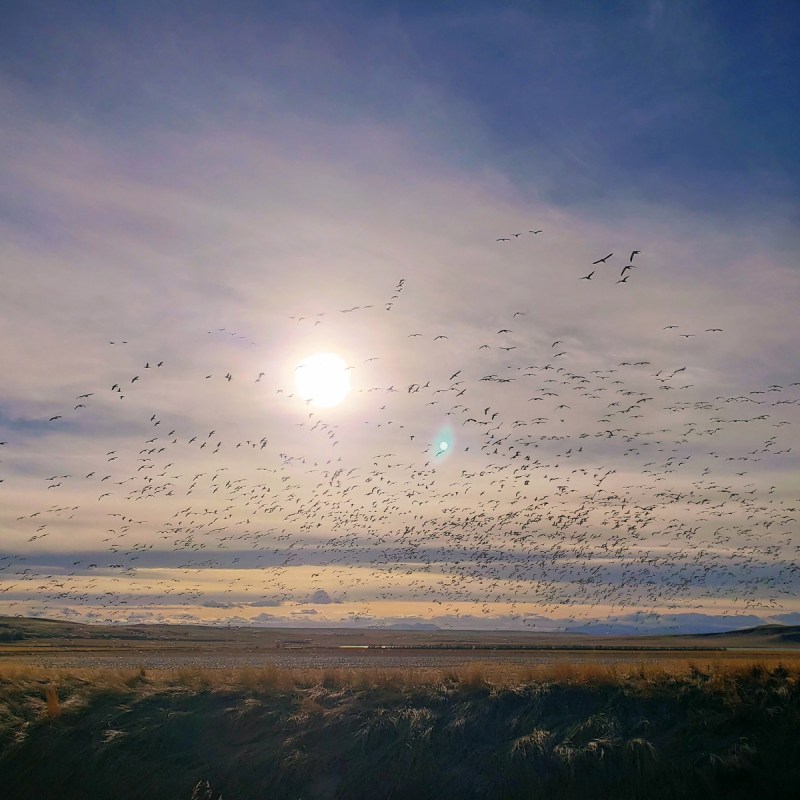
I had just arrived in Missoula after midnight, following a long, miserable flight, when my 94-year-old father-in-law, Wayne, spryly said we have to go to Freezeout Lake to see some birds.
Videos by TravelAwaits
I hesitated. I’m not a bird kind of guy, by any stretch. Then he said, “tens of thousands of waterfowl are on their annual spring migration.” I had no idea where the lake was or how long it would take to get there, but the words “tens of thousands” intrigued me.
We left two days later at 6:30 a.m. Along the way, we saw some interesting spots, learned some history, saw mundane yet frightening sights, and gawked at one of the most dramatic geologic phenomena I have ever seen. We also saw some birds! The round trip was 10 hours, including driving, viewing, eating, resting, and being amazed.

1. Garnet Ghost Town
About 31 miles east of Missoula off Highway 200 is an abandoned mining town now called Garnet Ghost Town, the most intact former mining town left in Montana. It was first mined in the 1860s. The town was formally established in 1895 and had periods of “boom and bust” as economics, geology, and technology dictated the mining (or lack thereof) of gold.
Getting to Garnet includes an 11-mile drive off Highway 200 on a surprisingly broad and well-groomed hardpack road. In its prime, Garnet, named after the semi-precious stones still found in the area, thrived with a population of up to 1,000 citizens. Among other buildings, the town had four hotels, a school, one assay office (a place that tests the purity of precious metals), and 13 saloons! Today, no one lives in Garnet, but with the efforts of the Garnet Preservation Association, many of the original buildings with relics and furniture of the time remain and offer a glimpse into the arduous world of late-19th, early 20th-century gold mining.
Garnet is open for visiting year round, weather permitting. There is a small entrance fee. Disability parking spaces are available, as well as generally accessible trails. Snowmobiles, snowshoes, or cross-country skies are necessary for access during the winter months. Great photos and further information are available on the site’s Bureau of Land Management page.

2. Rogers Pass — Baby, It’s Cold Outside
Highway 200 crosses the Continental Divide in the southern portion of the Bob Marshall Wilderness Complex via Rogers Pass at 5,610 feet of elevation. Not exceptionally high as passes go, but this pass is exceptional. It serves not only as a route through the mountains for vehicles traveling east and west across Montana, but also as one for migrating birds, including geese, swans, and golden eagles.
All well and good. The exceptional nature of Rogers Pass is that it holds the record for the lowest recorded temperature in the lower 48 states: -70 degrees Fahrenheit, measured on January 20, 1954. That factoid should win you a couple of friendly wagers.
3. Not Your Grandparent’s Grain Silos
The descent from Rogers Pass to the high plains of Montana is fairly steep and quick. When Highway 200 flattens out, it is then in the western portion of the Great Plains. And I found these plains spectacular: endless softly rolling fields of golden grassland punctuated by numerous small hills and buttes in the near distance and rugged snow-covered Rocky Mountain peaks running north to south in the far distance.
For me, these sites are thrilling. Other sites nearby are more chilling.
At irregular intervals, there are small, nondescript structures and grounds several hundred feet off the highway. Each has pole-like rods sticking up and what seem to be air ducts or narrow cylindrical domes nearby. All are surrounded by metal fencing. I looked for identifying signs but soon realized the lack of signage is the signage. These structures are nuclear Minuteman III missile silos. They are located in various clusters throughout the Great Plains. And can launch within a minute should the order ever be given. I guess one needs to be somewhat fatalistic to live in such areas because what leaves the silos will be returned in kind quickly.
Here is a short history via the National Park Service — and several photos of the Minuteman missiles.

4. Freezeout Lake Wildlife Management Area — Birds Of A Feather
The raison d’etre of this trip was to see birds. And we succeeded wildly!
The Freezeout Lake Wildlife Management Area covers approximately 12,000 acres and offers abundant wildlife viewing opportunities throughout the year. During a 2-week period in late March (the time of my visit), Freezeout Lake becomes an R&R (rest and refueling) area for migrating waterfowl — primarily Canadian geese, snow geese, and Ross’s geese, as well as trumpeter and tundra swans — which are heading north to Canada and Alaska from their winter homes in California, Texas, and the Gulf Coast states. They are the true snowbirds.

Up to 230 bird species, such as eagles, hawks, falcons, owls, mallards, shorebirds, and short grass prairie dwellers, plus other wildlife, have been identified here and are seen at various times of the year. But it is this late March period that is unusually spectacular.
We arrived around 9:15 a.m. and began a slow drive along the rocky dirt lanes which circumnavigate the chain of ponds comprising Freezeout Lake. Initially, we saw a few flights of incoming snow geese with several hundred birds per flight. We had missed the early morning outgoing flights, when the birds leave the lake en masse to find food in neighboring cut grain fields. We were now watching for incoming flights.

Around 10:15 a.. we noticed a wide, thick, dark, and undulating ribbon in the low sky to the south, resembling a linear black stratocumulus cloud. It soon became clear that this ribbon was not a cloud but an immense flight of birds, specifically snow geese, gliding in for a landing in one of the ponds. I watched, mesmerized by the number of geese and the precise choreography of their flight. It was as if each bird was receiving a simultaneous, common signal directing course, speed, elevation, and landing coordinates. Completely awesome! There could easily have been 10,000 geese in this one flight. The professional estimate made by the Freezeout Wildlife Area naturalists later recorded approximately 52,500 snow and Ross’s geese that day on the lake, along with 1,773 swans. Not one more or one less. During this late-March migration period, as many as 300,000 geese and 10,000 swans may pass through any given year.
When leaving a bit later, we passed the pond on which the large flight had landed. Complete cacophony. These geese and some of the 1,773 swans seemed quite proud of their flight and navigation skills and were surely not afraid to share their pride, squawking at us mere humans.
Pro Tips: Arrive early. Be patient. Dress warmly, bring snacks and water, carry binoculars, and if you want great photos, use zoom or telephoto lenses. (I didn’t, to my lasting regret. I’m just a point-and-shoot “celltographer”). The birds, generally, are at least 50–100 yards away. And they come and go on their own highly classified flight schedule and route.
The area’s official site has more history, information, and selected activities to do in the Freezeout Lake Wildlife Management Area.

5. The Front
Driving back to Missoula we passed through Choteau, a town of just over 1,700 folks, about 20 miles east of the Rocky Mountains. We drove southwest on Highway 287 for 45 miles or so until it met Highway 200, before heading home.
The scenery 287 caused a visceral reaction of awe in me. I stopped the car, got out, and gazed in amazement at this physical phenomenon: the imposing Rocky Mountain Front, the convergence of plains with mountains some 10–20 miles across the beautiful, stark western land. The Rockies just explode upward in a tangle of green forest at the base, becoming grey granite cliffs, and white, snow enshrouded peaks. Mile after mile after mile, running north to south.
One peak in this area is particularly striking: Ear Mountain (elevation of 8,560 feet), a sheer rock wall rising some 3,500 feet above the plains. The Rocky Mountain Front appears, for all intents and purposes, to be a massive barrier holding back all that is east of it. And in fact, in some ways, it is. The Front directly affects weather patterns in the Midwest by blocking warm, moist air from the Gulf of Mexico, facilitating thunderstorm and tornado formation. Further, there is no road through the Front between Rogers Pass and Marias Pass, more than 100 miles to the north, near Glacier National Park. Therefore, tough to traverse.
Additionally, this land contains one of the largest wilderness habitats in the country (The Bob Marshall Wilderness Complex), housing a multitude of wildlife, including wolves, mountain lions, grizzlies, and wolverines. Did I mention grizzlies? They frequently come off the mountains and roam the adjacent plains. Breaching the Front, this magnificent, massive wall of rock supported by a paucity of through roads and a plethora of patrolling predators, would be difficult! Personally, I would not wish otherwise.
Related Reading:
